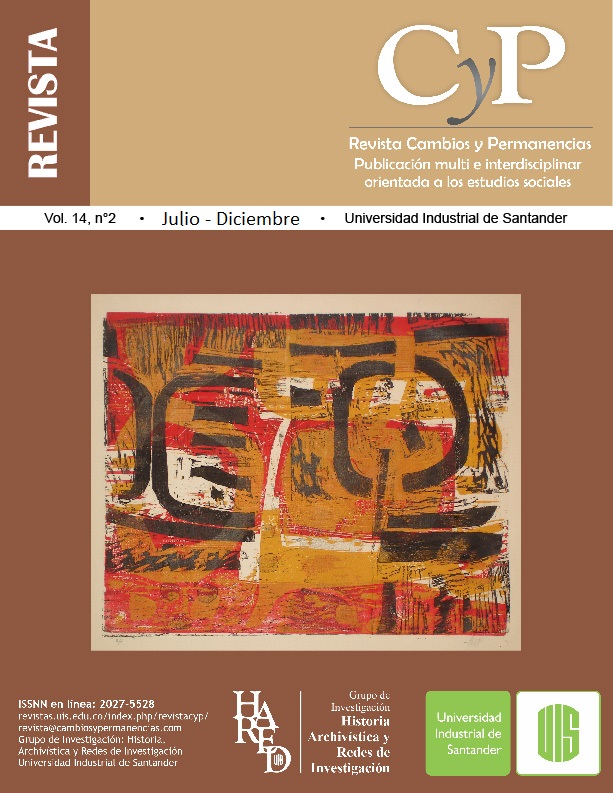Oil and violence in Arauca. Workers, armed conflict and repression (1983-2013)
Published 2023-10-30
Keywords
- Oil workers,
- Arauca department,
- enclave,
- Oxy,
- union
- armed conflict,
- violence,
- USO ...More
How to Cite

This work is licensed under a Creative Commons Attribution 4.0 International License.
Abstract
Objective: In this article we reconstructed a part of the historical evolution of the oil workers of the department of Arauca, located
in the Colombian Orinoquía, on the border with the neighboring country of Venezuela. We addressed some of the life trajectories of
the thousands of workers who arrived in the llanera region motivated by the discovery of the Caño Limón oil field in 1983. We analyzed their living and working conditions in the enclave built by the multinational Occidental Petroleum Company, more known as the OXY. We placed special emphasis on the various forms of repression that the oil workers have had to endure, in a department that has become a war laboratory for several decades. The workers have been left in the middle of the crossfire of the different armed actors that are fighting over the region. Methodology: We carried out field work in the city of Arauca where we interviewed oil workers and consulted the files located in the union sub directorate. Originality: Historical research on workers and violence has focused on the Andean and Caribbean regions, so it is necessary to address other territories. That is what we tried in this research by studying the oil workers of this plains area. Conclusions: The oil workers of the department of Arauca were essential to extract the riches from the subsoil. However, they have suffered the harshness of the armed conflict by being immersed in the violent dynamics of legal and illegal groups that operate in the region.
Downloads
References
- Archivo del Sindicato de Trabajadores de la Occidental de Colombia Inc. Contratistas y Subcontratistas, Arauca. Sintraoxy.
- Archivo Unión Sindical Obrera USO, Subdirectiva Arauca, Ciudad de Arauca.
- Caño Limón, Cusiana y Cupiagua, los pozos que rescataron a Colombia. (2018). Revista Semana. https://www.semana.com/contenidos-editoriales/hidrocarburos-son-el-futuro/articulo/cano-limon-cusiana-y-cupiagua-los-pozos-que-rescataron-a-colombia/590050/
- Celis, L. (2015). 30 años de petróleo en Arauca. El Espectador. https://www.elespectador.com/economia/30-anos-de-petroleo-en-arauca-article-603806/
- Contrato de Asociación Cravo Norte. Escritura Pública No. 354 de octubre 24 de 1.980. Notaria Treinta y Dos de Bogotá.
- De Currea Lugo, V. (2016). Historias del Sarare. De cómo el occidente de Arauca se fue poblando hasta convertirse en un sueño colectivo. Ediciones Ántropos.
- Dos muertos, quince heridos deja ataque con explosivos en Arauca. (2002). Caracol Radio. https://caracol.com.co/radio/2002/12/23/nacional/1040598000_110916.html 22/12/2002.
- El Latigazo, (1986), La Oxy arremete contra los trabajadores, Arauca.
- El Latigazo, (1990), Violencia en Arauca, Arauca.
- Espinosa Villa, Diego Mauricio. (2022). Arauca en la encrucijada: violencia, pobreza, desempleo y corrupción. El Espectador. https://www.elespectador.com/colombia/mas-regiones/arauca-en-la-encrucijada-violencia-pobreza-desempleo-y-corrupcion/
- Estadísticas del Departamento Nacional de Estadística., (2005)., Censo población y vivienda. Indicadores demográficos 1985-2005. Bogotá, Colombia.
- Frente Obrero USO-Arauca, (2009).
- Informe en Colombia de la Alta Comisionada para los derechos humanos de las Naciones Unidas (2002). Informe sobre la situación de derechos humanos en Colombia. E/CN.4/2.002/17, Bogotá, Colombia.
- Medina Gallego, C. (2011). FARC EP, Flujos y reflujos. La guerra en las regiones. Universidad Nacional de Colombia.
- Observatorio del Programa Presidencial de Derechos Humanos y Derecho Internacional Humanitario (2002). Panorama actual de Arauca y Casanare, Bogotá, Colombia.

